| 2/27/21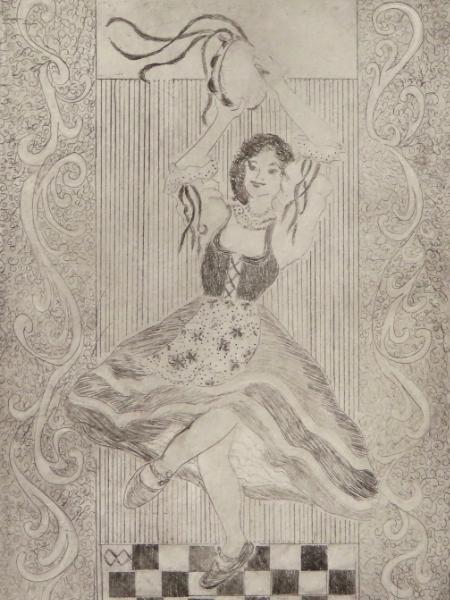 |
Country: Italy Drum: tambourine Border: Florentine design. Chess board (living chess game) Dry point etching Buongiorno/Good Day
Ciao/Hello/Goodbye/Greeting (Pronounced: cha-ow)
Drum: A Tambourine is a hand-held drum, with the leather “head” stretched around a thin, circular frame. Often pairs of metal disks called zills are inserted into the frame to provide a jingling rhythm sound when the drum is struck by hand or “rolled” (shaken back and forth). The Tambourine (or similar smaller instruments) is found in references from Mesopotamia, Egypt, Israel, West Africa, Greece and Ancient Rome. Dance: Tarentella The Tarantella is a traditional folk dance from the region of Calabria in southern Italy. It is one of the country’s most popular dances, performed at weddings, celebrations, and happy gatherings of all sorts. The dance is upbeat, with quick steps, and is often performed in a sideways line with participants (including children and seniors) holding hands. It can also be performed by couples as a courting dance. As I was working on this project, I was surprised to find the origin of the name comes from a kind of wolf spider (not related to the big, furry, poisonous spider you are probably thinking about.) This spider was first found in the province of Taranto, Italy. Some folks thought fast twisting and jumping could serve as an antidote to the spider bite, while others thought the action was a result of the bite. (I had never heard these name explanations before.) Since my father’s family came from Calabria, I have danced many Tarantellas at family weddings, from when I was a little girl being pulled into the line by “old” aunts to becoming one of the aunts (not too old, now) who does the gathering. Just working on this art piece brought back wonderful memories. Traditional Attire: The dancer in this print wears the traditional folk dress of the region: a ribbon decorated skirt, white “peasant” blouse, laced weskit and white apron. Sometimes a large, triangular scarf is tied around the dancer’s waist. Ribbons are often attached to the blouse and to the tambourine, also. Border: The border I chose to create was based on an Italian Renaissance design. I have always loved the swirling graceful patterns, so prevalent in Florence and elsewhere in Italy. I started with the large flourishes on a hand-made ceramic plate I bought in Tropea, Italy, and then added the Florentine swirls to create tonal value. Tropea, is a picturesque cliff-side village in Calabria (Southern Italy) on the Tyrrhenian coast.
The checkerboard base border is a reference to a marvelous event I witnessed on the other side of Italy, near the northern border in Marostico, at the edge of the Alps. This castle town has a huge chessboard in its central plaza. Every other year since 1454 (at least according to legend), a live chess game has been played here. The spectacle of the show, with costumed performers and live horses (chess knights) is quite wonderful to see. If you want to learn more about this event and see some photos, I’ve attached an article I wrote about it for Renaissance magazine in 2019 (you may be able to enlarge it) and a photo showing the Knights on horseback, the queen and other players.. References and Links: Tambourine. Encyclopedia Britannica. https://www.britannica.com/art/tambourine 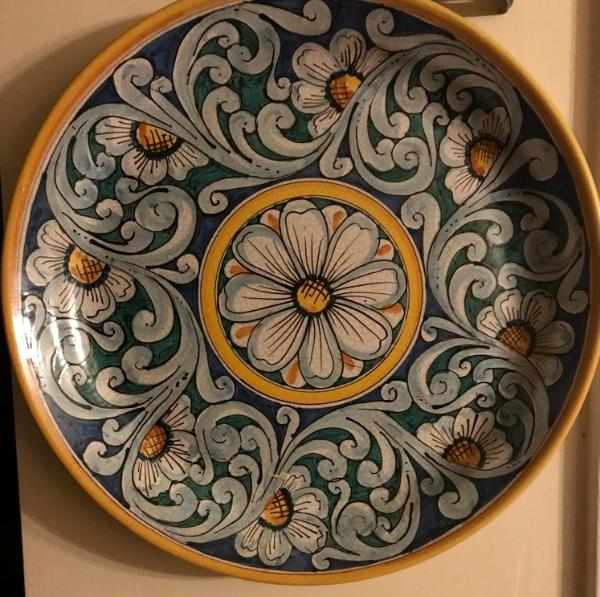 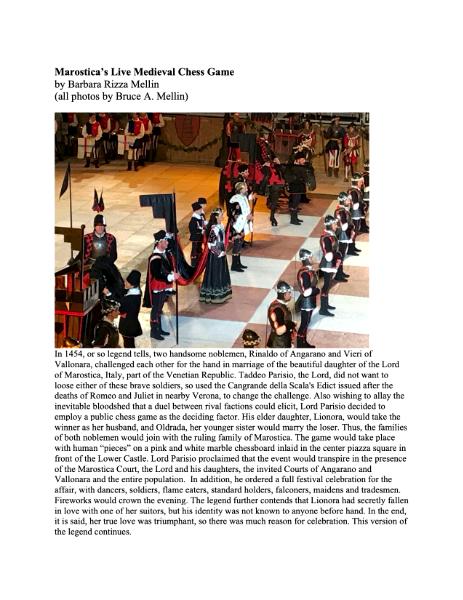 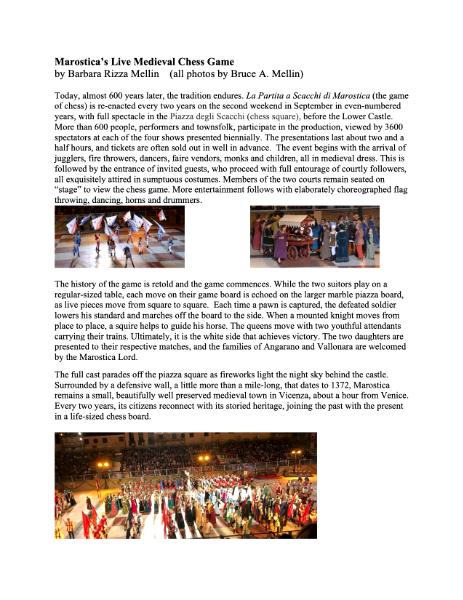 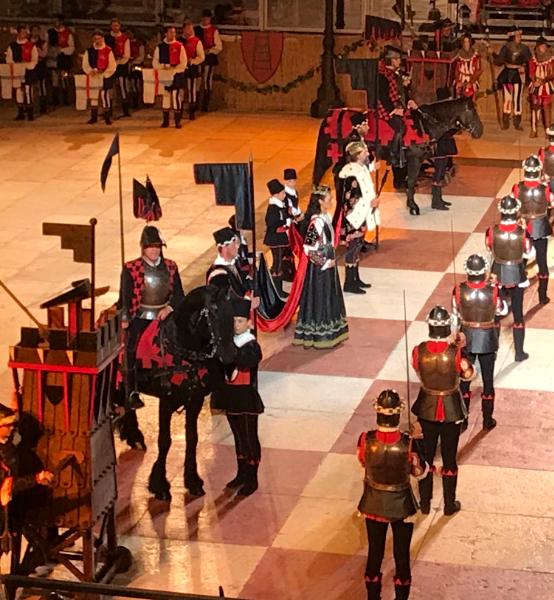 |
Be the first to post a comment.
|
2/27/21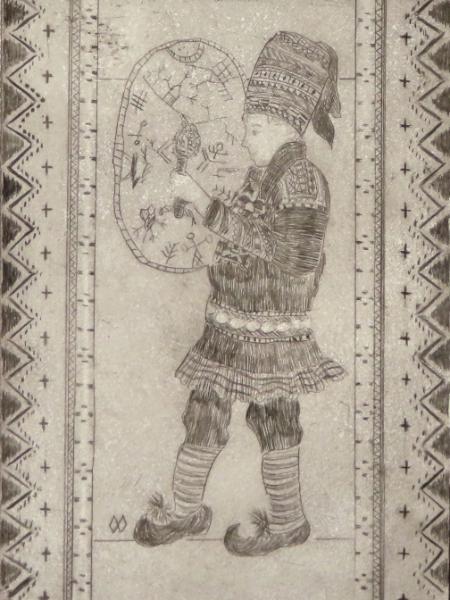 |
Country/People: Saami (or Sami) people of Norway and northern Finland and Russia . . . . . (Lapland) Drum: ancient-style runebomme (rune drum) Border: Traditional patterns found on Saami clothing Dry point etching (on aluminum plate) Bures/ Hello in Sami Drum: runebomme (rune drum) While they don’t all speak the same language, there are about 80,000 Saami, who consider themselves one people, and about half of them live in Norway. Their land, the broader area that reaches across northern Scandinavia into Russia, is known as Sápmi by these indigenous people. (It has been called Lapland by non-Saami, but that term is often seen as pejorative by the Saami.) This ancient Rune Drum covered in untanned reindeer hide and decorated with rune markings became a symbol of Sami culture, something to be preserved, especially in the 17th and 18th centuries as Sami beliefs were being challenged by Christianity. The oval-shaped instrument is typical of the frame-style drum, with a geometric figure representing the sun in the center and with additional symbols around the sun, representing people, animals, landscape and deities. The Sami shaman or noaidi would beat the drum with his hand to put himself into a trance. It was the belief that while in this trance state, he could visit the spirit world and obtain information about the future. (The “Sami Drums” site listed below has illustrations of traditional drum decorations.) Border: traditional Saami attire patterns The drummer, pictured here, is wearing the characteristic Sami outfit known as the Gákti, which, is a point of pride for the Saami people even today. His is the Guovdageaidnu- style (from that region, near the Finnish border.) The Gákti consists of a unisex-style pullover. (The men’s top is a little shorter than the women’s.) He wears a belt ornamented with metal couching with pewter wire. This clothing tends to be brightly decorated with color-block strips of material and areas of detailed design. These areas may at first look like embroidery, but they are rather appliquéd rows of ribbon or patterned weaving. The shoes or short boots, often made of reindeer hide and fur, turn up at the end. The pointed, hooked-toe ends are particularly suited for skiers. The footwear is tied to the legs with colorful ribbons and laces. References and Links ( Note: I do not endorse or mean to promote any of these sites.) |
Be the first to post a comment.
|
2/24/21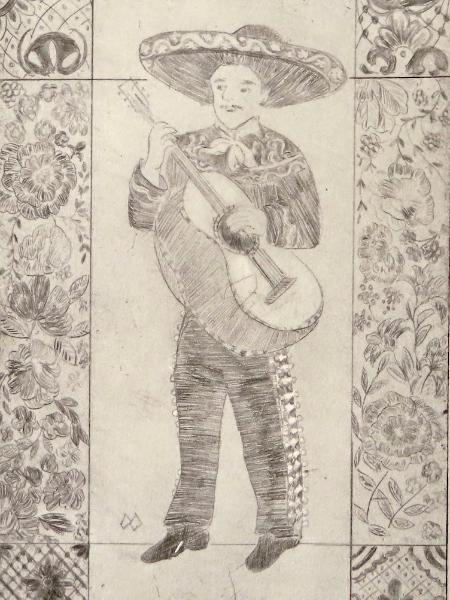 |
People/Country Mexico Instrument: Guitarrón Mexicano Border: Talavera Pottery Corners: Maya huipiles pattern (Guatemala/ Mexico )
Hola/ Hello Buenos días/ Good Day Music: In 2011, the iconic music of Mexico, Mariachi Music was added to the UNESCO Representative Heritage list. Once thought to be an indigenous Mexican word, the term Mariachi is now believed to be a mix of Spanish and Mestizo, dating back to the early 1800s. ( The arrival of Cortes, with European harps, violins and guitars in the early 1500s influenced the traditional music of the country.) Mestizo music is a mix of influences by Spanish conquistadors, Indigenous Mexicans, and African Slaves.
Originally, the Mariachi bands played traditional folk songs and corridos (Mexican ballads that told tales of bravery, love and outstanding deeds), but today, they have added a broader repertoire often based on popular requests. The size of a Mariachi group and the combination of instruments in the groups have also varied over the years, and may often include two violins, two trumpets, one Spanish guitar, one vihuela (five-string, high pitched instrument), and one guitarrón, the deep-bodied six string instrument shown in the etching. While the guitarrón Mexicano may seems like a variation of a guitar, it is actually closer related to 16th century Spanish bajo de uno, or fingernail-plucked bass. The guitarrón is a fretless instrument with heavy gauge strings and provides the signature sound of Mariachi music. Mariachi Attire: Perhaps the most recognizable parts of the traditional Mariachi folk costume, which has remained virtually unchanged for centuries, is the charro suit and the sombrero, a wide brimmed hat, usually made of straw or felt (rabbit or horse hair) . The mariachi musicians wear a “gala” or dress version of the national charro suit. The charro has evolved from the 17th century outfit worn by Mexico’s indigenous horsemen. The Spanish introduce the horse to the American continent, but forbade indigenous people to ride without their permission. The native people were forbidden to dress like their Spanish “masters” and later “employers,” who didn’t want them confused with elite landowners. So a unique riding outfit evolved. It was a suit with a cropped jacket and tapered pants made from leather and suede and richly embroidered with images of local plants stitched with fibers from local plants and cacti. The Charro (rather like the American Cowboy) became a kind of folk hero, recognized for his expert horsemanship, strict code of conduct, and later for supporting the fight for Mexican independence. Today, the outfit is worn with national pride. Charros participate in the national sport, Charreada (Rodeo), which was added to the UNESCO Intangible Cultural Heritage of Humanity list in 2016. There are various styles of the charro suit, but the gala Mariachi is often black with silver fretting decoration. The sombrero is usually elaborately decorated (the decoration is called toquilla) often in silver Borders: The side borders are taken for huipiles patterns. Huipils/ Huipiles (pronounced wee-peels) are the blouses (tunics) worn by indigenous Mayan women of Mexico and Central America, especially Guatemala. The patterns and designs of a huipil may identify an individual, her village and even some societal elements, such as whether she is married. These pattens are woven into the fabric on a back strap loom. Often embroidery elements are added. The finished garment is a true work of art. Today, it is one of the most popular pieces of women’s clothing worn in Mexico. It is also part of the traditional dress of the Maya in Guatemala. Indigenous Maya make up more than half of the 12 million people who live in Guatemala. I’ve attached a picture of a huipiles weaving on a model of a back strap loom. (Other blogs from the “7 Looms a Weaving” group will showcase back strap weaving cultures.) Corners: Talavera pottery patterns. Talavera pottery or ceramics are found both in Mexico and in Spain. The patterns and process have been passed down from the 16th century Spanish center Talavera de la Reina. Both areas are on the UNESCO Intangible Cultural Heritage list. Mexican Talavera, usually from Puebla and Tiaxcala, is a type of majolica or tin-glazed earthenware. Typically, the white base is painted with bold blue designs. Other bright colors are also added. Because traditional Talavera was made by hand, using expensive cobalt pigment on natural clay, which had to be dried for several months, it was about three times more expensive than other earthenware. Today, only pieces from certified workshops in Mexico are allowed to be labeled Talavera . Although the process for making this pottery is specific, complicated, and time-consuming, Talavera pottery is used for utilitarian products, such as bowls, cups, flowerpots and tiles. I have never been to Mexico, but I was fortunate to acquire several small Talavera bowls at the largest Mexican market in America in San Antonio, Texas. I used the designs on these for the border inspiration. And while I was in San Antonio, I visited the Alameda Museum to view the Smithsonian exhibit of huipiles weavings of the Mayan people of Guatemala, where I acquired the loom . (See image below. Note the remarkable detail that is achieve with this thin-thread warp.)
References and Links: ( Note: I do not endorse or mean to promote any of these sites.) - Clark, Jonathan. D. 1996. A Brief History of the Mariachi Tradition. https://content.westmusic.com/resources/brief-history-of-mariachi/
- Charro: a Brief History of how the Mexican cowboy became a national fashion model. 8/5/2018 HauteCutureFashion.com
- A Brief History of Huipils https://theculturetrip.com/north-america/mexico/articles/a-brief-history-of-the-huipil-in-one-minute/
- Guatemalan Huipils (with video): guatemalanhuipils.com/
- Https://ipfs.io/ipfs/qmxoypizjw3wknfijnklwhcnl72vedxjqkddp1mxwo6uco/wiki/Guitarron_mexicano.html
- Muhammad Danial Harith bin Zulkifli and Dhiviya Kannusamy. Guitarrón Mexicano
- Traditional Instruments of the World. https://traditionalmusicalinstrumentsblog.wordpress.com
- History of Mariachi. Puro Mariachi. http://www.mariachi.org/history.html
- Illustrations of loom and huipiles and an explanation of the process and tradition. See these two nationalclothing.org articles for illustrations of loom and huipiles and an explanation of the process and tradition.
- Traditional Mexican costume.Typical pieces of clothing in Mexico Nationalclothing.org/ 8/12/2014
- Traditional blouse of Guatemala. Maya women weave their folk clothing on backstrap loom 2/4/2018
- The craft of weaving huipiles – female tunics of Guatemala – might vanish because of a huge market of underpriced secondhand huipiles 2/4/2018 http://nationalclothing.org/america/82-guatemala/243-the-craft-of-weaving-huipiles-–-female-tunics-of-guatemala-–-might-vanish-because-of-a-huge-market-of-underpriced-secondhand-huipiles.html
- Mariachi, string music, song and trumpet. Https://ich.unesco.org/en/RL/mariachi-string-music-song-and-trumpet-00575
- UNESCO: https://mariachimusic.com/about/history/
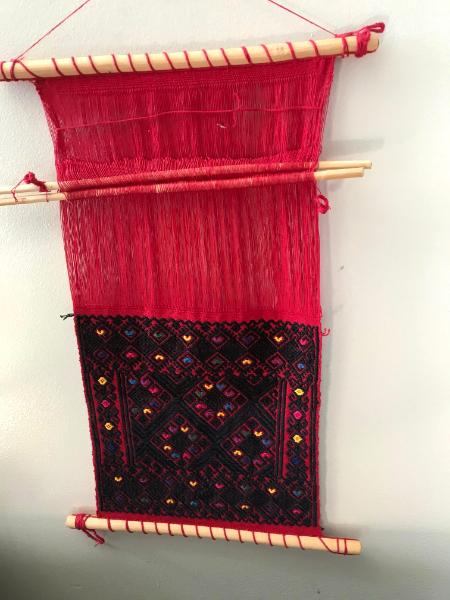 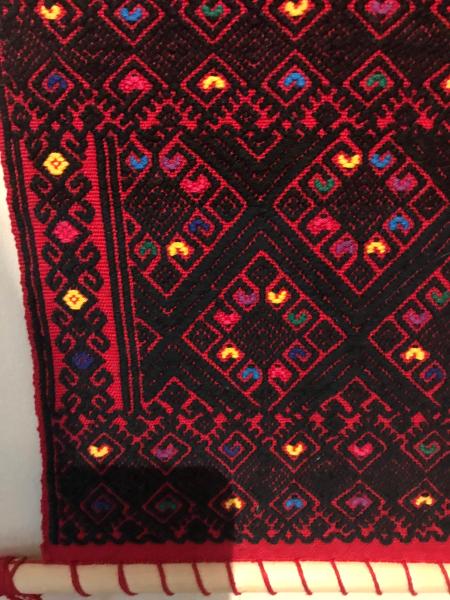 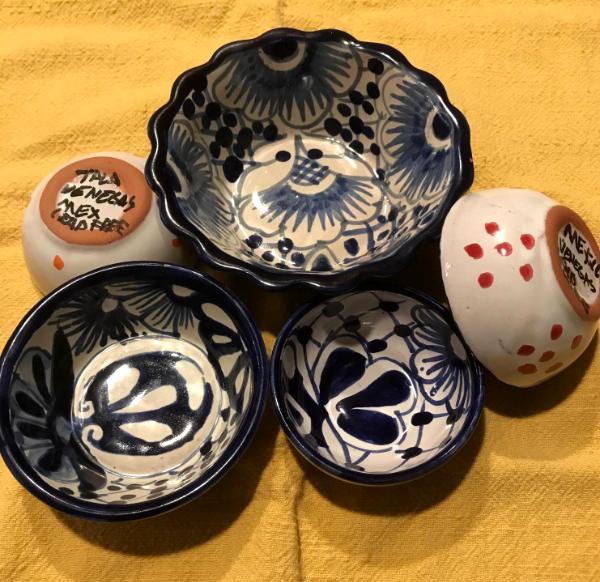 |
Be the first to post a comment.
|
2/17/21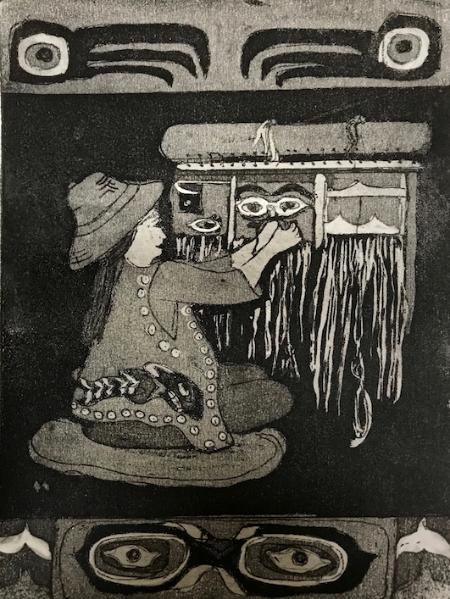 |
People/Country: Tlingit, Haida, Tsimshian Indigenous peoples / Northwest Coastal North America Loom Style: Chilkat loom, no fixed warp, no shuttle Border: Woven Tlingit ceremonial robe (Naaxein) pattern Copper sulphate/salt etching
Yak’eí (yagiyee)/Good day
Done by Tlingit, Haida, Tsimshian, and other indigenous peoples of British Colombia and Alaska. Chilkat weaving, named for one of the Tlingit groups, is perhaps the most complex technique and unlike most weaving techniques, allows for the creation of circular patterns and curvilinear lines. Looms used in Chilkat weaving have only a top frame and vertical supports, with no bottom frame, so the warp strands hang down freely, and the weft threads are twined and manipulated by hand without a shuttle. The pattern is woven from top to bottom, and extra warps are added as needed for complex patterns and to make the curved bottom border.
Traditionally, men would paint a life-size pattern board that a woman weaver would follow to create a ceremonial robe. Sometimes pattern boards were used over and over, and though there were strict conventions, there were also opportunities for individual interpretations. Animal forms make up the patterns. Often almost human-like eyes form the center pattern and represent the inner spirit of the animal. (The U. of Rochester link below provides an excellent audio explanation of the common robe images and symbols.) Skilled weavers, today, are working at preserving the traditional methods. The weft can be left a natural off white or dyed. Hemlock bark yields black; wolf moss produces yellow; and the addition of copper could makes blue. The warp is leg spun (rubbed together by hand along the weaver’s leg) into dense strips that can be worked or finger twined by hand. Since there is no fixed base to hold the warp straight and no shuttle to control the cross strips, unlike in most weaving processes, the Tlingit weaver can weave circles and oval shapes into their designs. The free-falling warp allows for long (12 inches or more) fringe threads at the bottom of the robe. The material traditionally was mountain goat wool and stripped cedar root. As many as five goats were needed to provide wool for one robe. (Now, sheep and domestic goat wool may be used. The long thin cedar “runner roots,” not the strong base root are harvested for weaving. It takes an artist up to 2,000 hours, or 83 days, to weave just one ceremonial robe. And it could take a year to weave a blanket. When I visited Vancouver, Canada, I made a special trip to the Museum of Anthropology at the University of British Columbia, just outside the city proper. I highly recommend it. This amazing museum holds an outstanding collection of “First Nation” cultural artifacts ( 50,000 ethnographical and 535,000 archaeological objects!), from authentic totem poles, to potlatch bowls as big as a small boat, to Tlingit weavings, even a model Haida house
According to the museum information:“Chilkat robes were symbols of wealth: to own them endowed a chief with great prestige. Even greater prestige resulted from giving them away in potlatch.” (If you have a chance, research the potlatch custom. You will find it quite fascinating.) The robe could also be cut into strips and given to several important guests if no one person of high rank was present. These strips would be made into ceremonial garments, such as aprons, leggings, headdresses or bags The weaver is wearing a button vest, another clothing item associated with the Tlingit peoples. Button-decorated tunics and blankets became part of native attire once trade with Russia and other Europeans brought felt and beads. Mother of pearl buttons were often used to outline animal images and symbols of specific tribal clans. The hat shown here is also typical of Northwest Coast indigenous peoples, such as the Haida, the Tlingit, the Kwakiutl. The hats, made of spruce root or cedar bark, were often painting with spirit animals. As Dr. Gerald F. Schroedl points out, such hats were most useful in the rainy climate of the Northwest Coast.
References and Links: ( Note: I do not endorse or mean to promote any of these sites.) - Benson, Diane E. Tlingit. Countries and their Culture. Traditional Garments and Regalia. (Lots of additional reference source.)
- Chilkat Robe (Naaxein) Memorial Art Gallery, University of Rochester (NY). https://mag.rochester.edu/teachers/picturing-the-story/the-chilkat-robe/ An excellent audio description of a Tlingkit robe design. Very revealing.
- Dockstrader, Frederick J. Indian Art of the Americas, Museum of the American Indian.1973 print
- Jones, Cynthia. Chilkat Blanket.1987 Haines Shelton Museum. https://www.sheldonmuseum.org/vignette/chilkat-blanket/
- MOA. Museum of Anthropology. University of British Columbia, Vancouver, BC, Canada. Search collection.
- NationalClothing.org /“Discovering American Indian Art” at the McClung Museum of Natural History and Culture
- Taylor, Sherry. Lily Hope: Tlingit Weaver of Chilkat and Ravenstail. Handwoven. 3/11/2020 https://handwovenmagazine.com/lily-hope-tlingit-weaver-of-chilkat-and-ravenstail/
- Tutter, Catherine. 16/5/2019. Textiles in Context. Chilkat Blanket (Native American, Tlingit, 1900-1914) https://textilesincontext.net/2019/05/16/chilkat-blanket-native-american-tlingit-1900-1914/ Image: MFA, Boston.
|
Be the first to post a comment.
|
2/13/21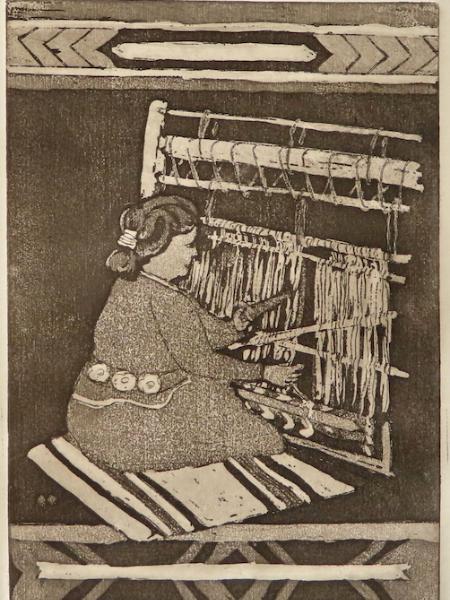 |
Country/People Navajo Native American (Southwest USA) Looms: up right Border Sample Navajo Weave Copper/sulphate/salt etching Yå’ ´åt’eeh / Hello Loom: Navajo rugs are recognized and appreciated throughout the world for their distinctive geometric patterns. The Navajo loom is a an upright loom. Weavers sits on the ground in front of it and weaves from the bottom to the top. The warp (vertical threads) itself is prepared off the loom and then placed onto the loom form. Because the Navajos at one point were nomadic, this was an important key aspect to their weaving. They could remove the weaving in progress from a loom and travel to a new place where they would build another loom and place the weaving back onto it (Mirrix). Anthropologist believe the Navajo first arrived in the American southwest in the early 1300s, but a clear record of their weaving history cannot be documented until the 1600s, with the arrival of Spanish conquistadors, and with them, sheep, in particular Churra sheep with wool that is easily spun and woven into long threads of yarn (Explore).
The woman pictured here dresses in traditional Navajo clothing: a long-sleeved blouse (often velvet) called a jeiji’eé´ and a skirt (usually cotton or velvet) called a tl’aakal. Around her waist is a belt/sash with silver conchas (medallions.) The Navajo work silver and turquoise as part of their spiritual, as well as decorative, aspects of life. Her hair is styled in a tsiiyéél, brushed back with a be’ezo or stiff, long, dried grass and tied with white sheep wool string. The Border at top and bottom as samples of the type of weaving done on a Navajo loom. The Navajo called themselves Diné meaning the people, and Diné Bikéyah (land of the Navajo), extends 27,000 square miles. It is larger than 10 of the 50 states in the US! Today, different regions of the Navajo region have established identifiably distinct color and design patterns for their rugs. I purchased two rug square samples of Navajo weavings when visiting the Navajo Reservation in Arizona on my way to Monument Valley and the ancient cliff dwellings at Canyon de Chelly, way back in1969. I also purchased a model of the Navajo loom. As you can see, I’ve been an admirer of Navajo weaving for a long time. See photos below. References and links: ( Note: I do not endorse or mean to promote any of these sites.) 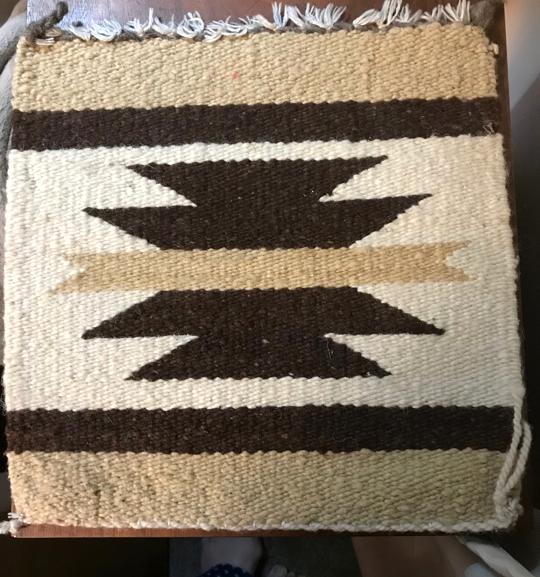 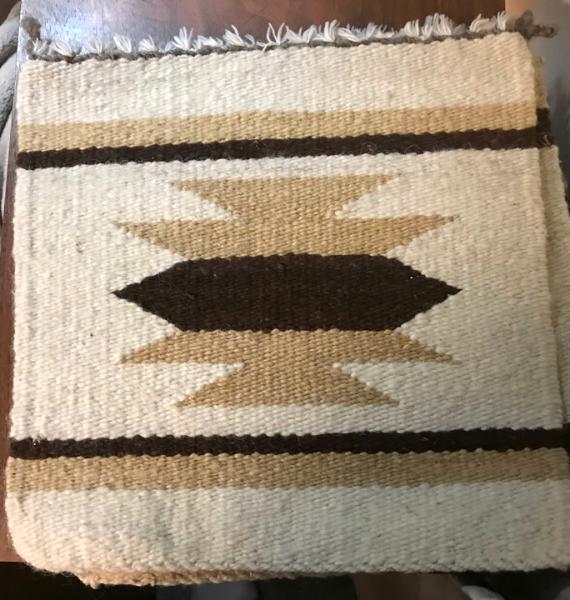 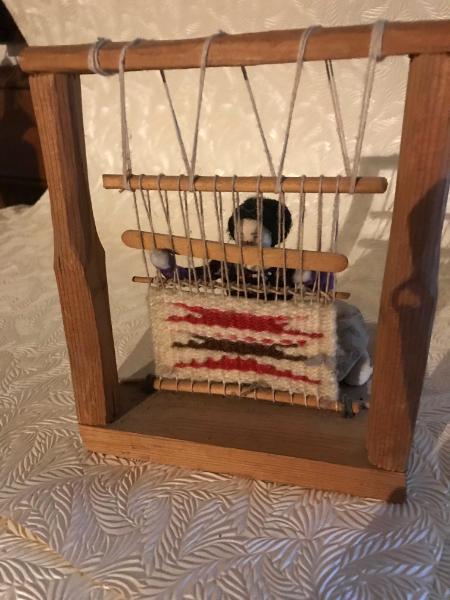 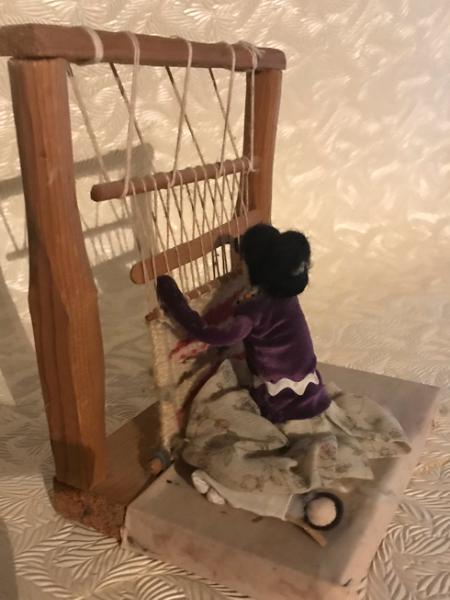 |
Be the first to post a comment.
|
2/13/21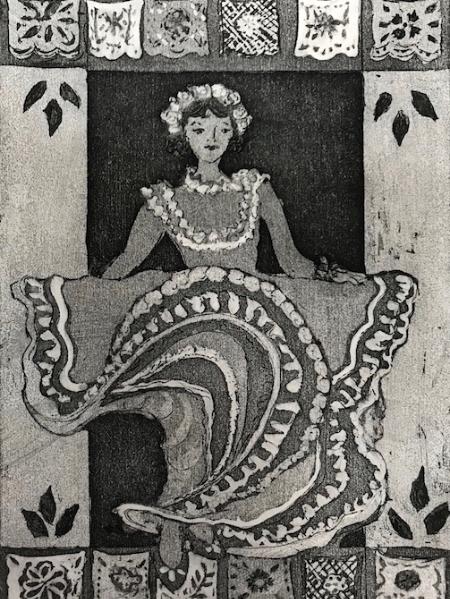 |
Country/People: Mexican Dance: Folklorica Border: Papel Picado and Poinsettia leaves Hola/ Hello in Spanish/Mexican Dance: Folklorico is a word used collectively to describe Mexican folk dances, and there are many which reflect traditions, customs and costumes from different regions. One of the most recognizable is the Jalisco folk dance dress, with wide sweeping skirt made with yards of material and colorful ribbons. It is sometimes called an Escaramuza dress. When the women dancers move and swirl the skirts, they create great circles of color and rows of lines. One Song/Dance called The Son of La Negra (which is suppose the resemble the sound of a locomotive in the opening chords) is often danced to Mariachi music* and features these swirling skirts. The image below is of a group of young dancers performing a Folklorico dance in Jalisco folk dance dresses at El Mercado, the Mexican Market Plaza in San Antonio, Texas. The swirls of color and motion (too swift for the camera to capture) create a fabulous sense of energy and drama. If you look closely, you will also see papel picado in the background. Check out one or more of the video links below to see performances. (Also, see Blog on Mariachi music/ “6 strings a playing”, when it is posted.) Border: Papel Picada refers to the banners of cut paper “flags” that hang above Mexican towns and villages for celebrations and festivals. When I visited the Mexican Market in San Antonio, Texas (The largest Mexican Market in the U.S) the streets were lined with lattice-like papel picada. I fell in love with the bright colors and festive spirit they generated. These tissue paper flags are used as decorations on the Day of the Dead, Christmas, Independence Day, some religious holidays, festivals and other celebration. Papel picada literally means ‘punched’ or ‘perforated’ paper. While they may appear to be cut with fine scissor, they are traditionally made by craftsmen who score through multiple layers with a hammer and a chisel. As many of 30 to 50 sheets of tissue paper may be pieced at one time. So, rather than being cut out, the design is actually chiseled through a piece of stencil paper or Manila paper onto which the pattern is drawn and stacked atop layers of tissue paper. The perforated papers are then clued to a string and hung throughout the city. On September 22, 1998, the governor of Puebla State proclaimed the artisanal papel picado from San Salvador Huixcolotla, a part of the State's cultural heritage. The tradition of hanging such banners probably dates back to Aztec times, where a form of bark paper, decorated with melted rubber was used. The thin paper versions on papel de china or tissue paper was adapted later under Christian influence. Images often have religious or traditional meaning, such as angels and nativity scenes for Christmas and skulls for Day of the Dead. Colors, too, may have symbolic and religious significance, such as purple for Easter and vibrant pinks and oranges for Day of the Dead. (Check the sites below for images.) Poinsettia "leaves/petals" at the sides. The Poinsettia plant are named for the first US ambassador to Mexico, Dr. Joel Roberts Poinsett, who fell in love with these “flowers” and brought them to the US (So. Carolina) in the 1820s. At first, in the 19th century the plant wasn’t that popular in the US, but by the 20th century it had gained in popularity and became associated with the Christmas holiday because of its green and red color combination. Dec. 12 is Poinsettia Day (It is the day Joel Poinsett died in 1851.) Actually, this plant does not have red flowers. The red portion is the bracts or modified leaf growth. The tiny yellow flowers (Cyanthia) in the center are rather inconspicuous next to those vibrant red leaves. After the flowers spread their pollen, the bracts and leaves fall off. While not exactly poisonous, eating parts of the plant can make you sick. However, one would have to eat many, many bad-tasting leaves (more than 500) to be harmfully affected. The Aztec used the leaves medicinally to control fevers. They also made a reddish fabric dye from the bracts. Today, 70% of all commercial Poinsettias are grown on the Paul Ecke Ranch in California. In Mexico and Guatemala, the plant is called La Flor de la Nochebuena, ( Flower of the Holy Night/ Christmas Eve.) The image at the bottom is a tinted dry point etching I created of Poinsettia. References and Links: ( Note: I do not endorse or mean to promote any of these sites.) - Agur, Dinah. Folk Art Guide: Papel Picado. https://www.mexican-folk-art-guide.com/papel-picado.html#.YCgg8hNKggG
- nationalclothing.org/ Beautiful Mexican Jalisco folk dance costume 10/9/2018
- nationalclothing.org/ Traditional Mexican costume. Typical pieces of clothing in Mexico 8/12/2014
- Palfrey, Dale Hoyt. Mexican traditional papel picado: Classic art for a Mexican fiesta. Mex Connect. 1/1/1999. https://www.mexconnect.com/articles/1567-mexico-s-traditional-papel-picado-classic-art-for-a-mexican-fiesta/
- History of Mexican Papel Picado Cut Paper Banners https://mexicansugarskull.com/pages/history-of-mexican-papel-picado-cut-paper-banners
- Seltzer, Erica D and MaryAnnSpinner, University of Illinois Extension Master Gardeners. Poinsettia Facts. 2021. https://web.extension.illinois.edu/poinsettia/facts.cfm#:~:text=10%20Interesting%20Facts%20about%20Poinsettias.%201%20No%20flower,500%20leaves%20to%20have%20any%20...%20More%20items
Folklorico dance costumes throughout Mexico.
http://nationalclothing.org/america/21-mexico/823-folklorico-dance-costumes-throughout-mexico.html
- Folklorica videos:
- https://www.youtube.com/watch?v=dSaiZMtabj4
- https://www.youtube.com/watch?v=L1zsP1plkCY
- https://www.youtube.com/watch?v=XEDB6H03xOk
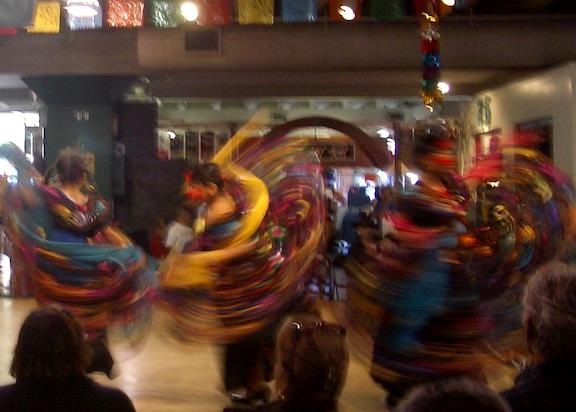 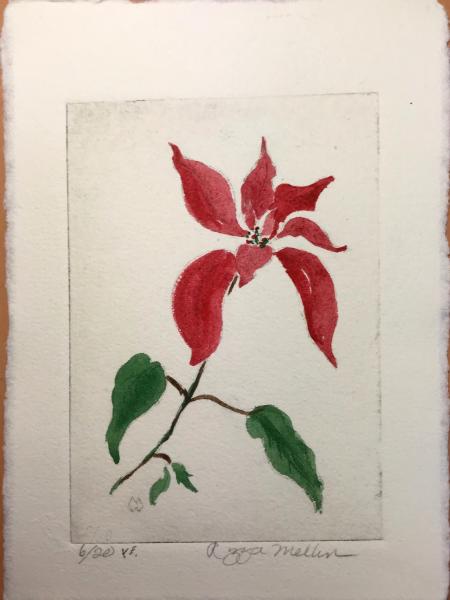 |
Be the first to post a comment.
|
2/11/21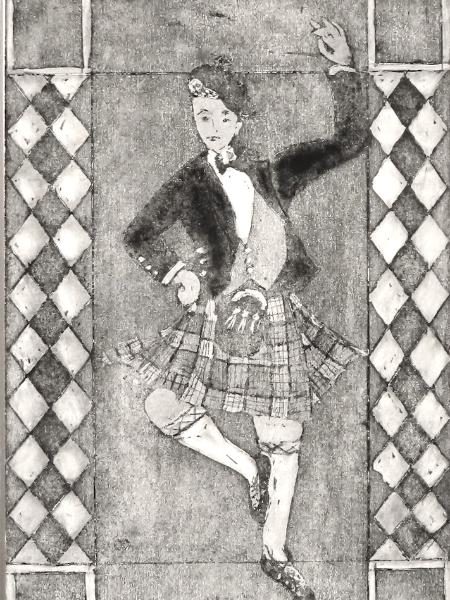 |
People/County Scottish, Scotland Folk Dance: Highland Fling Border: Argyle haló (ha-LAW) (Scottish Gaelic)
Highland Dance: Scottish Highland Dancing is said to have originated during the Highland Games, when kings and clan chiefs sought to find their best warriors. Dancing was one of the competitive events, with participants imitating epic deed of Scottish folklore. This particular style of dancing, which involved steps around a sword, requires agility, dexterity, strength and stamina. The origin, according to a BBC documentary, is that Scottish warriors danced over their weapons after a victorious battle, often crossed swords laid upon the ground. The dance, then and now, was probably accompanied by traditional Scottish bagpipe music. The marriage of Alexander III to Yolande de Dreux in 1285 is the first record of this “war dance” being performed to the music of bagpipes. Another account says the Highland bagpipes were first mentioned in Scotland in the 1400s and usually with reference to military life. The dance competition has remained an important part of Highland Games, but now more than 90% of the participants are women, today. There are actually a few versions: Including The Sword Dance and the Highland Fling. (The Ben Johnson History post below gives the origins and folklore behind several of the dances. And the Scottish Official Highland Dancing Association offers information.)
Traditional Dress: The dancer is wearing what might be considered the national clothing of Scotland. The most obvious garment is the kilt (or short pleated, usually plaid, “skirt” worn by men.) Originally, it was probably a large cloth wrap the went around the waist and over the back and shoulders. At some point this became two pieces: one for the shoulder and one to tuck into or attach to a waist band. It should fall no lower than mid-knee. The kilt, once banned, was saved by being part of military uniforms. While they could be solid colored, kilts are usually made of Tartan (a plaid associated with a particular clan). Traditional Scottish tartans have 2 to 6 colors. The clan’s crest might also appear on the Balmoral beret cap. In addition to the pleated kilt, drawn closed with a horizontal strap buckles and kilt pin, the national dress includes a vest and jacket, which hits at the waist, knee-high socks (hose) with flashes (garters) and sgian dudn (small knife), and lace shoes called ghillie brogues. He may also wear a sporran hung from a chain around his waist. This is a sort of purse, wallet, or in earlier time gun-holder for the pocketless kilt and traditionally has three tassels in front. Border: The diamond shape design of Argyle gets its name from the Argyll branch of the Scottish Campbell clan. It was based on their tartan design. However, now the word has a broader, more general reference. Scottish Highlander have worn this pattern on the knit stockings since the 17th century. They often referred to as tartan hose.
Bonus Scotland Info: National animal of Scotland is the mythical Unicorn. According to Scottish legend, the unicorn is both pure and powerful, and almost impossible to tame. King William I chose the unicorn for the royal coat of arms in the 12th century, as did King James VI of Scotland in 1603, and it has been a national symbol ever since. (Travel Trivia) References and Links:( Note: I do not endorse or mean to promote any of these sites.)
|
Be the first to post a comment.
|
2/9/21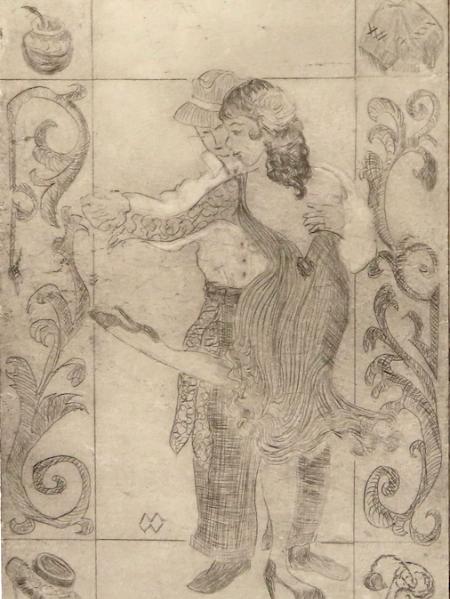 |
Country/People: Argentina Dance: Tango Border: Fileteado , Corners: Gauchos Dry point etching Buenos días / Hello, Good Day Tango: Originated in the 1880s as a social dance played at bars and brothels along the Ria de la Plata between Argentina and Uruguay. Tango combines elements of African Candombe (discussed in a different blog), Spanish/Cuban Habanera and Argentinian Milonga. One explanation of the name Tango is that it comes from the Spanish Tambo, which referred to a musical gathering of slaves. Although such gatherings were banned at times, the music and dance remained popular. Eventually, with immigration, it spread throughout the country and beyond, but was often considered too sexual and shocking by many conservative audiences. By the early 20th century, however, Paris and other European cities were captivated by this new dance introduced by performers and orchestras from Buenos Aires. By 1913, the dance instructors who had introduced the tango in Paris were banned from teaching, as it was again perceived as too sexual. Still it was charming New York City and Finland, who had modified the moves and music to create “North American Tango” and “FinTango.” (More about FINTango in another blog). As an acceptable dance, it has gone in and out of favor, but under Argentine ruler, Juan Perón, it became a symbol of national pride in Argentina. The dance is traditionally accompanied by a type of concertina, called a bandoneon. The bandoneon, originated in Germany and continued to be produced there for Argentine markets. In 1930 alone, 25,000 instruments were sent to Argentina. Tango is recognized by both Argentina and Uruguay on the UNESCO Intangible Heritage list. Border: The style of decoration, with cured filigree lines and stylized flowers and vines, that decorates the sides of this etching is known as Fileteado Porteno and has been found throughout Buenos Aires, Argentina since the beginning of the 20th century, when it was used to paint wagons. (People from the port city of Buenos Aires call themselves Portenos.) The Filetes (“thread” lines in fileteado style) often surround or interweave with poetic phrases or sayings (sometimes irreverent). Characteristically, fileteado contains flourishes, scrolls, and lines to create shadows and bright colors. It adorns everything from shop signs and taxis to busses and restaurant menus. This traditional sign art is created by a technique in which wax paper is perforated in the desired shape of the design and then “traced” through the tiny holes to transfer the pattern to the surface for the application of enamel paint Fileteado Porteno has been added to UNESCO’s Intangible Cultural Heritage of Humanity list. See link below. Corners: The Gaucho is another national symbol of Argentina, but it is also associated with Chile, Uruguay, Paraguay and Brazil. Similar to the folk hero status of the North American western cowboy, the skilled horsemen of the South American Pampas (grasslands), popular in the mid 18th to 19th centuries, are subjects of folk legends, songs and literature. Mostly Mestizos (a blend of European and Indian heritage), they were considered brave, unruly, irreverent and resourceful. In the early 19th century, Gauchos fought in the Rio de la Plata region to help Argentina break away from Spanish colonial control. The images shown in the corners of this dry point represent some of their most recognizable attributes (clockwise from upper left): maté, poncho, bola, and bolero. Maté: This national drink of Argentina, Uruguay, and Paraguay and consumed throughout South American, originated with the Guarani indigenous peoples of the area. Made from soaking the yerba maté herb and special holly leaves in hot water to make a caffeine-rich “tea” with healthy benefits, maté is drunk through a metal straw (bombilla) from a hollowed gourd cup, The cup is also called a maté because it is used for this drink. Poncho: This blanket-like garment has been around since ancient times, but the name poncho comes from the Quechuan word puchu. From Peru, it was acquired by the gauchos as an all- purpose “accessory” used for warmth, as a saddle blanket and for sleeping. Boleadoras (bola): The bola is a throwing weapon made from three connected leather cords with stone balls attached to the ends. It is thrown to capture an animal by tangling around its legs. Evidence of bolas have been found in pre-Columbian settlements in Patagonia, where they were used by indigenous people (especially the Teheulche). Bolero: The bolero is a typical hat often worn by gauchos (and Spanish dancers). Its stiff, flat brim protected their eyes from sun on the open Pampas (grasslands). Some gauchos also wore a beret, reflecting their connection to the Basque people of northern Spain and Southern France around the Bay of Biscay. (See another blog about Basque dancers.)
References and Links: ( Note: I do not endorse or mean to promote any of these sites. I list them here as sources of information. ) - Knowles, Mark. The Wicked Waltz and Other Scandalous Dances
- Jemio, Diego. The musical key to keeping Argentina dancing the tango. BBC News 4/11/14. https://www.bbc.com/news/business-29896409
- Sterns, Gaby Herrera. The Craftsmanship Initiative. Fileteado Porteño: Preserving the iconic street art of Buenos Aires 19/6/2019. https://craftsmanship.net/blog/fileteado-porteno-preserving-the-iconic-street-art-of-buenos-aires/
- UNESCO Filete porteño in Buenos Aires, a traditional painting technique https://ich.unesco.org/en/RL/filete-porteno-in-buenos-aires-a-traditional-painting-technique-01069
- UNESCO Tango https://ich.unesco.org/en/RL/tango-00258
|
Be the first to post a comment.
|
2/9/21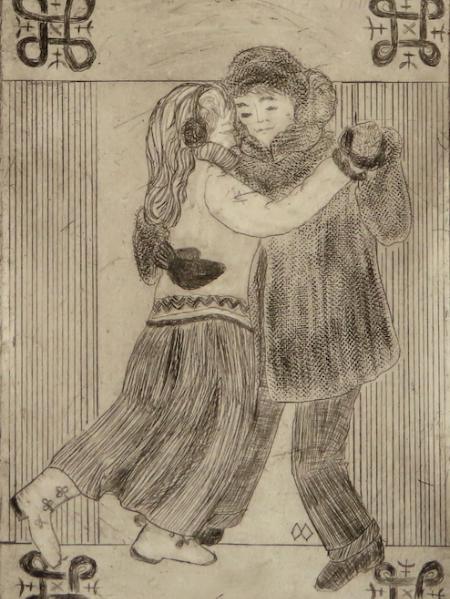 |
Country/People: Finland Dance: FINTango Border/Corners: Hannunvaakuna Dry point etching on Aluminum plate Hyvää päivää / Hello in Finnish (See blog on Argentina Tango for background information about the dance and its origins.) I have to say, I was quite surprised to learn that the world’s oldest and largest Tango Festival is the Tangomarkkinat, held annually since 1985 in the Finnish town of Seinäjoki, usually in July. This festival attracts more than 100,000 participants. And millions more watch it on T.V. (I’ll remind you that the total population of Finland is only a bit over 5 million.) In fact, Tango is so popular in Finland, there are several noteworthy festivals held throughout the year, including The International Helsinki Frostbite Tango Festival, usually held in February. Tango came to Finland in 1913 by way of Buenos Aires orchestra performances in Europe, and over the years, this Scandinavian country has made the music and the dance its own. As distinguished from Argentine Tango, Finnish Tango follows ballroom tango rhythms and is almost exclusively performed in minor keys. The traditional Spanish bandoneon (discussed in the Argentine Tango Blog) has been replaced with an accordion. Significantly, while the music themes may still be about love and longing, they are most often related to Finnish folklore or the changing seasons: love of nature or longing for childhood memories, for example. Corners: You may recognize the symbol shown in the corner squares as the “Command” icon on an Apple computer. But this symbol, called Hannunvaakuna in Finnish, has a much deeper history. It is actually an ancient mark that represents Good Luck/Good Future in Finland and in many other Scandinavian countries. It is found on houses and barns to discourage evil spirits, and as a decorative element on everyday utensils and clothing. The oldest example was discovered on a 1000-year old pair of Finnish skis (Finnish Museums). Since the 1950s, the Hannunvaakuna has been used in Finland on signs to identify “Places of Interest.” References and Links: ( Note: I do not endorse or mean to promote any of these sites.) - C.G. The Economist. Explaining the Finnish love of Tango. 11/10/2017. https://www.economist.com/prospero/2017/10/11/explaining-the-finnish-love-of-tango
- Virtual Finland. The Story of the Finnish Tango. http://virtual.finland.fi/netcomm/news/showarticle.asp?intNWSAID=26960
- ( Department of Archaeology. "Ski fragment". Nat'l Board of Antiquities (in Finnish). Helsinki: Finnish Museums Online. p. KM9908:1. Archived from the original on 3 December 2013.)
|
Be the first to post a comment.
|
2/9/21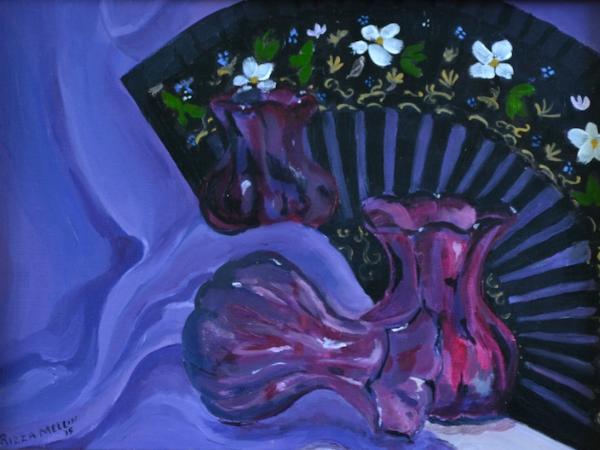 |
(Since the next set of blogs focuses on fans : 3 Fans Friends, I thought I'd get you into the spirit by posting an article I wrote some time ago in my syndicated column, ArtSmart Travels. It is about my visit to the Fan Museum in Greenwich, England. No, I didn't know about it beforehand either. It was an accidental find, and it was actually I the reasoning I started the column in the first place. I thought others should know about it also. I wrote the column for years after, and it was published around the world. I fell in love with fans after that visit and started collecting fans as I traveled. I have a lace fan from Venice, a handmade paper fan from Florence, and an elephant dung fan from Laos, and many more. They have managed to find their way into some of my artwork also. I've posted a few samples. Hope you enjoy this extra blog and it inspires you to find something you love that reminds you of the people you've met and the places you've been. )
A "Fan-tastic" Museum in Greenwich, England
Did you know fans have been part of civilization for at least 3000 years? One of the discoveries in Tutankhamun's tomb was a fan with an L-shaped ivory handle complete with ostrich feathers. Ancient Greeks and Etruscans make references to fans in life and myth, while painted silk fans date back to fifth-century China. Until I discovered The Fan Museum, while visiting Greenwich, England, I hadn’t realized that fans were this interesting. I didn’t know, for example, that the earliest fans were flat ceremonial devices, often covered with gold leaf. By 1500, folding fans were evident, first in Italy and then throughout Europe. By the 17th century, France had become the leading source of fashionable fans, and by the 18th century, Queen Elizabeth I helped established their popularity in England. And fans as still a fashion accessory in Spain. This unique Museum—the only one in the world dedicated exclusively to the history of fans and the art and craft of fan-making—is located at 12 Crooms Hill, within two, beautifully restored 18th century townhouses conjoined by a reproduction Georgian Orangery. In 1985, the abandoned town houses built in 1721 were purchased to contain and conserve the over 2,000 fans and fan leaves collected and donated to the nation by Hélene Alexander. After extensive restoration, the museum opened to the public in 1991. Sitting in the shadow of the Greenwich Observatory, this unassuming, little gem today houses over 3000 fans from around the world dating to the 11th century, A permanent exhibit illustrates the history of fans and the art of fan-making. However, only a portion of the collection, often combined with other loaned fans, is displayed at one time in exhibitions, which change about every three months. Spokeswoman for the museum Alexandra Moskalenko explained to me that many of the fans are delicate and should not be open and exposed to light for longer periods of time. Neither should the fans be stored in a closed position for extended periods. If you walk through the exhibitions, you may be surprised to discovered the variety of styles, materials and construction of fans. One mid-18th century fan, for example, contains a stylized visage with cut-out eye holes; when held before the face, it provided a no-strings-attached mask, ready for costume-parties or coy flirtations. In some cases, fans are printed on both sides; one side might present a respectable image from an opera or play, while the other side reveals a more erotic scene. I learned that not all folding fans consisted of single folded leaves; some, like the style made popular by Jenny Lind, had individual petals. There are several "Jenny Lind" fans in the collection, including one of Alexander's originals that alternates blue and white embossed petals tipped with feathers and decorated with curvilinear rococo scrolls swirling around silvered birds, lover's knots and roses. The monture. or rib portion, is bone with pierced sticks and guards gathered together by a mother of pearl rivet and a thin gilt metal loop. In addition to collecting and displaying fans, the museum provides research and conservation services, conducts workshops on crafting fans, and creates custom-designed fans for businesses and special events such as the limited edition fan, with moveable clock hands, created to commemorate the millennium in 2000. An excellent example of form meeting function, fans purposefully blend decoration and utility to create a unique work of art, both practical and pretty. The Fan Museum reminds us that people throughout history have valued this combination that brings beauty, meaning and art into our everyday lives. It also reminds us that sometimes the most interesting travel experiences are found off the well-traveled path. _______________ In additional to the "3 Friends Fans" images I'll be posting soon that showcase traditional dances from Bali, Fiji and northern Norway, with fans, check out these upcoming blogs that also show or discuss fans in a folk heritage: Jingle Dress Dance of the Ojibwe (5 Olden Rings), Singkill Dance of the Philippines (5 Olden Rings) Flamenco Dancer/Spain (9 Ladies Dancing) Sesath Shade Fan Border/Sri Lanka (12 Drummers Drumming.)
I've also posted here three artworks of my own that focus on fans: 1. A large 3-D Chinese fan with brush painted flowers on rice paper over an actual fan I purchased in China. I like the way a few of the Chinese letter characters are slightly visible through the rice paper.
2. Next is collage from my Pandemic Interior series, showing a hand colored dry point etching of my fan collection.
3. I bought the fan in the opening oil painting (Spanish Fan with Cranberry Glass) in Toledo, Spain to add to my collection. With its dark, black, color block creating stripes against the purple background, I thought it formed an excellent backdrop for my mother-in-law's collection of Cape Cod Cranberry Glass vases. 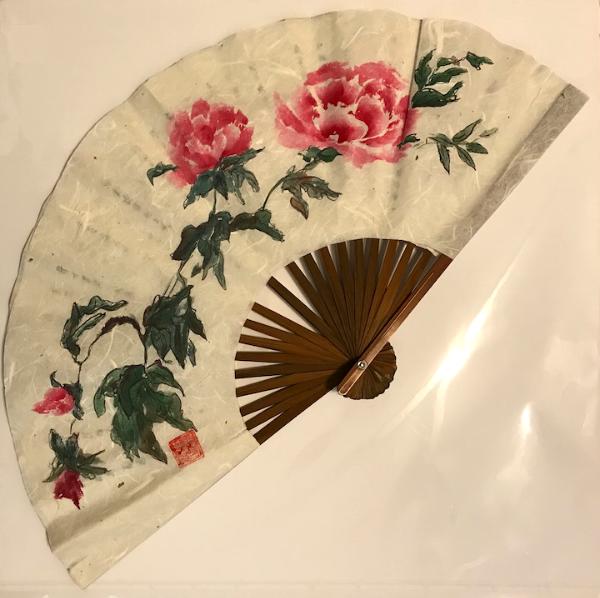 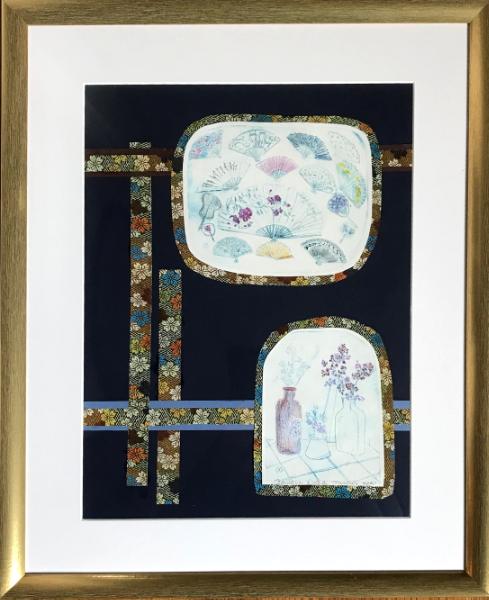 |
Be the first to post a comment.
|
Previously published:The Art and Writing of Barbara Rizza Mellin RSS |  |
|